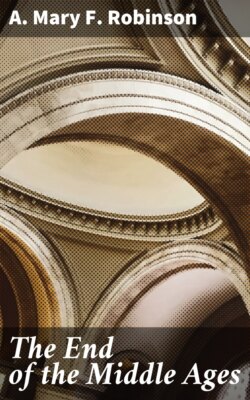Читать книгу The End of the Middle Ages - A. Mary F. Robinson - Страница 6
На сайте Литреса книга снята с продажи.
III.
ОглавлениеTable of Contents
The success of the Beguines had made them an example; the idea of a guild of pious uncloistered workers in the world had seized the imagination of Europe. Before St. Francis and St. Dominic instituted the mendicant orders, there had silently grown up in every town of the Netherlands a spirit of fraternity, not imposed by any rule, but the natural impulse of a people. The weavers seated all day long alone at their rattling looms, the armourers beating out their thoughts in iron, the cross-legged tailors and busy cobblers thinking and stitching together—these men silent, pious, thoughtful, joined themselves in a fraternity modelled on that of the Beguines. They were called the Weaving Brothers. Bound by no vows and fettered by no rule, they still lived the worldly life and plied their trade for hire. Only in their leisure they met together and prayed and dreamed and thought. Unlettered men, with warm undisciplined fancies, they set themselves to solve the greatest mysteries of earth and heaven. Sometimes, in their sublime and dangerous audacity, they stumbled on a truth; more often they wandered far afield, led by the will-o’-the-wisp of their own unguided thoughts. In the long busy hours of weaving and stitching they found strange answers to the problems of human destiny, and, in their leisure, breathless and eager, discussed these theories as other men discussed their chance of better wage. Such were the founders of the great fraternity of Fratres Textores, or Beghards as in later years the people more generally called them. And their philosophy is so strangely abstract and remote that we could not explain it, did we not know that from time to time some secular priest or wealthy and pious laymen joined the humble fraternity. And the priest would bring, to their store of dim wonderings, thethe Alexandrian theories of the pseudo-Dionysius, then, in all the monasteries of Christendom, deemed the very corner-stone of sacred philosophy. We can imagine how eagerly these simple folk would seize the hallowed fragments of Erigena and of the Areopagite, and how they would treasure them as holy secrets in the depth of their tender and mystical souls. We know that now and then a consecrated priest would join the unsanctioned but pious order of the Beghards; it is no great stretch of fancy to suppose that from time to time, some Crusader, fresh from the East, would bring them his memory of Eastern theories; that some scholar would add a line from Avicenna or Averroes. Through some channel, it is evident, the Beghards received the last feeble stream of Alexandrian theory. Their vague, idealistic pantheism is but an echo of Plotinus and his school. From the monasteries, from the Arabian commentators on Aristotle, or directly from the East, these fragments of neoplatonist philosophy must have reached them; and out of them there should be evolved, first of all, the great metaphysical heresies of the Middle Ages; and, later on, the habit of mind that should produce the German Reformation.
